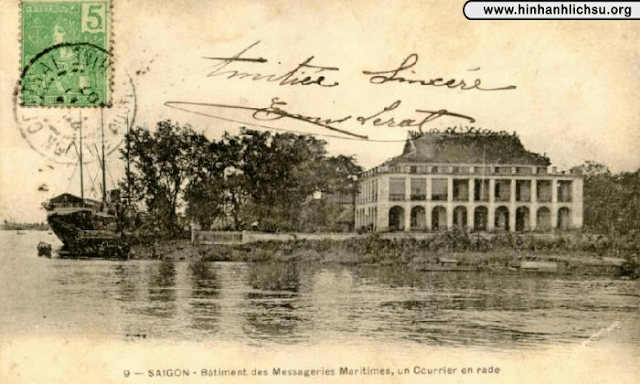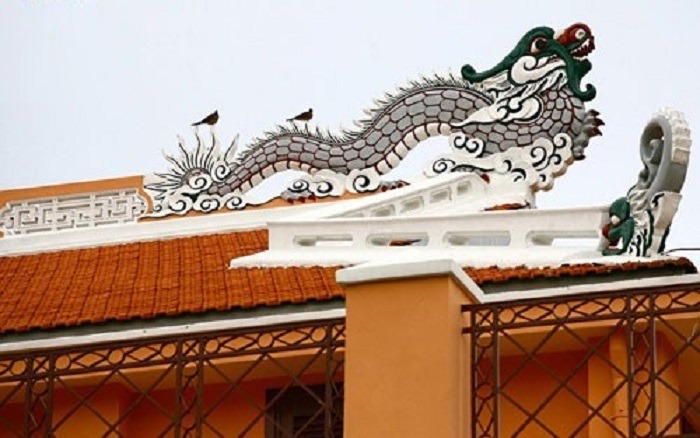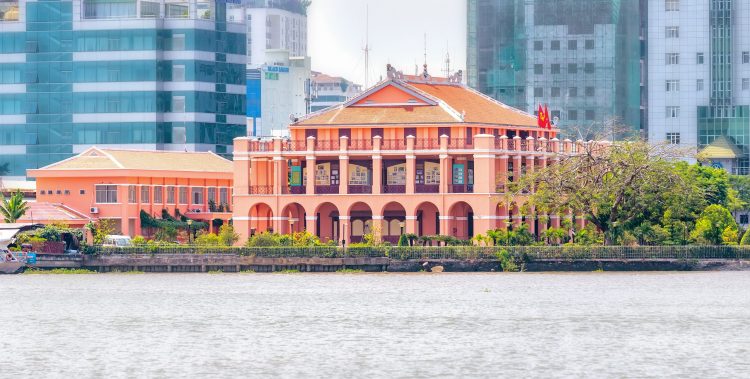Nha Rong Port: Footprints in Vietnam’s History

Nha Rong Port is a well-known cultural site as well as a symbolic part in a sprawling network of ports within the city. The port attracts millions of tourists every year thanks to its serene architecture and historical significance, marking Ho Chi Minh’s footprints in Vietnam’s history.
Many people, even locals, tend to forget this, but Saigon is actually a port city. Located by the bank of Saigon River, which gives it an edge in naval transportation as compared to other cities nearby, the city houses many important harbours in the region, a factor that has helped it to become the commercial hub of the South of Vietnam.
For tourists, this fact might sound irrelevant, but it actually underlines a very important, albeit often forgotten, part of the city. In fact, it is thanks to Saigon’s aptitude for naval transportation that the country’s history was made: In 1911, the young Nguyen Tat Thanh, later known as Ho Chi Minh, left Vietnam on the ship of Amiral Latouche Tréville, which, at that time, was docking at Nha Rong Port. With this first step, Nguyen Tat Thanh has launched into his quest of helping his homeland to regain its freedom, and he would spend decades after on foreign lands in search of the right path to independence. To commemorate this historic event, Nha Rong Port has now been converted a museum dedicated to Ho Chi Minh.
A trip to Nha Rong Port is a must on almost every history lover’s itinerary. In fact, besides the fact that it was the place where Nguyen Tat Thanh left on a 30-year journey, it is also culturally and archaeologically compelling.
The History of Nha Rong Port

Nha Rong Port is one of the oldest French-colonial structures in the city of Saigon. After taking over South Vietnam from the Nguyen Dynasty, the French colonial government wanted to build a commercial port to make use of the city’s location and expand naval commerce. The entire construction contract was given to the company Messageries Impériales, and the first ports were built in the Ben Thanh Area within a year. Later on, the company built an administrative building which governed the entire port complex. It also acted as the residence for the port admins.
The port’s Vietnamese name, which translates to House of the Dragon, is a matter of dispute. There are two main leading theories: The first and the more popular one posits that the name comes from a dragon statue which perches on the top of the headquarter building.
The second one contests that the name of the building stems from the King Gia Long’s name, since Gia Long translates to Nha Rong in Vietnamese. The theory posits that the French would like to commemorate the king’s good relationship with France by naming the building so. However, this theory has been widely discredited by scholars.
In 1865, the port authority had erected a flagpole on top of a local watchtower called Thu Ngu for the purpose of sending signals to approaching ships. The locals called the pole Cot Co Thu Ngu, and the landmark is still visible to this day. The pole’s construction itself is quite unique, making it an interesting location to visit when you are here.
See more on 5 Best Shore Excursions in Ho Chi Minh City
The Unique French-Colonial Architecture

Nha Rong Port is a staple of French-Colonial architecture, but it isn’t wholly French. The building boasts two porcelain dragons perching on its roof, not unlike the imposing gargoyles of yore on the grand cathedrals of Europe, with their eyes inquisitively following every passer-by. Decorating buildings with statuettes of dragons was not an uncommon practice at the time in Vietnam, as the mythical creature was held in high regard. However, it was rare for a Western building to be adorned with Eastern elements, and with Nha Rong Port, the two worlds seem not to collide but rather complement one another to create an amazing display of architectural flair.
The roof section of the building was renovated by the government of South Vietnam in 1955, which saw the two original dragons replaced by two new ones. Since then, the structure of the building has hardly changed, thanks to the preservation effort on Ho Chi Minh City’s authority.
After the war was over, Saigon Port gained prominence as the main commercial port in the city, thus Nha Rong Port was phasing out. However, its legacy lived on as local authority turned it into a museum dedicated to Ho Chi Minh, his achievements, history, and legacies. If you are interested in the legacies of one of the greatest leaders in the 20th century, this museum is one of the must-see tourist sites in Ho Chi Minh City.
Things to take notice of when you visit Nha Rong Port

Since Nha Rong Port is a museum now, there are certain things you will have to keep in mind the next time you visit the landmark:
- Opening hours: The venue is open from Tuesday to Sunday every week, from 7:30 to 11:30 in the morning and 13:30 to 17:30 in the afternoon. It would be a nice idea to visit the port in the afternoon, as you could see the sun setting on the Saigon River.
- Tourists could consider taking a taxi or the bus to the port. Currently lines No. 3 and No. 20 pass through Nha Rong Port – Ho Chi Minh Museum.
- Because the museum is dedicated to an important figure in Vietnam’s history, tourists are advised to dress and behave properly when visiting this place.
In addition, take note of the following shore excursions from Nha Rong Port if you are interested in exploring the unparalleled sceneries and many other interesting things to do and see in Ho Chi Minh City: Ho Chi Minh City Private Tour, Private Cu Chi Tunnels & War Remnants Museum, Private Cu Chi Tunnels and Ho Chi Minh City Highlights, Mekong Delta Private Tour.
See more on Ho Chi Minh City Cruise Port Guide: Picks for Your Next Stop
Saigon is a city rich in both history and culture. Now with a Vietnam e-visa, you can enter Vietnam through this port much more easily. Nha Rong Port is one of the remaining relics of the city’s founding days, and because it has always been there, in spite of Saigon’s tumultuous history, the port is considered a historical witness to the city’s ups and downs. It truly is a worthy landmark to visit, even if you are not much of a history fan.
© Copyright
Viet Nguyen written for Maika Tours
You Might Also Like:
Phu My Port: How to Perfect Your Shore Excursions